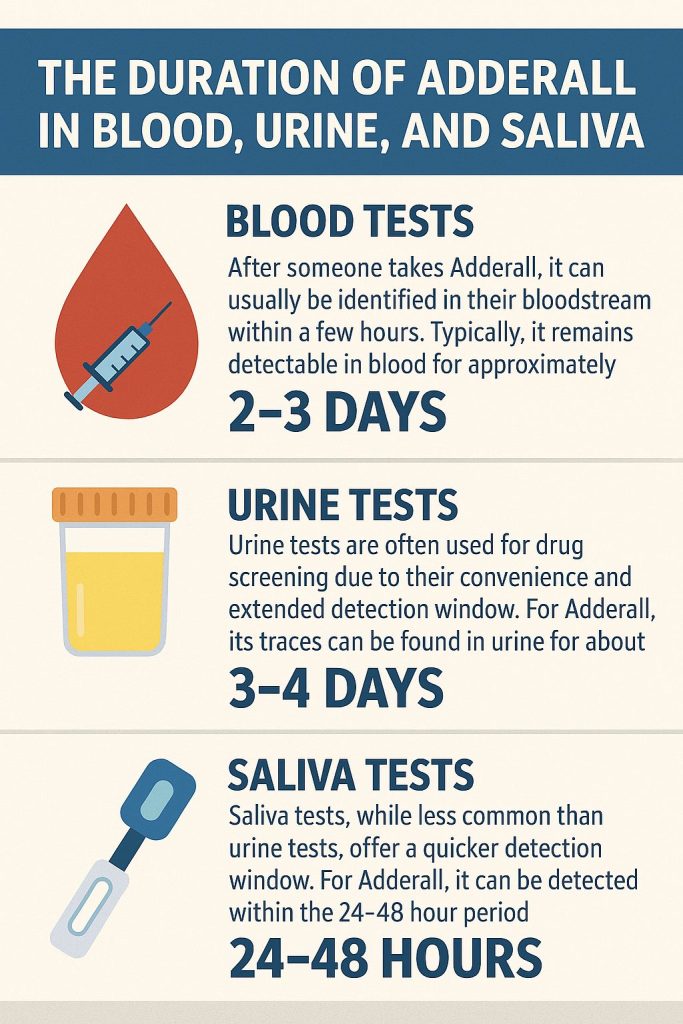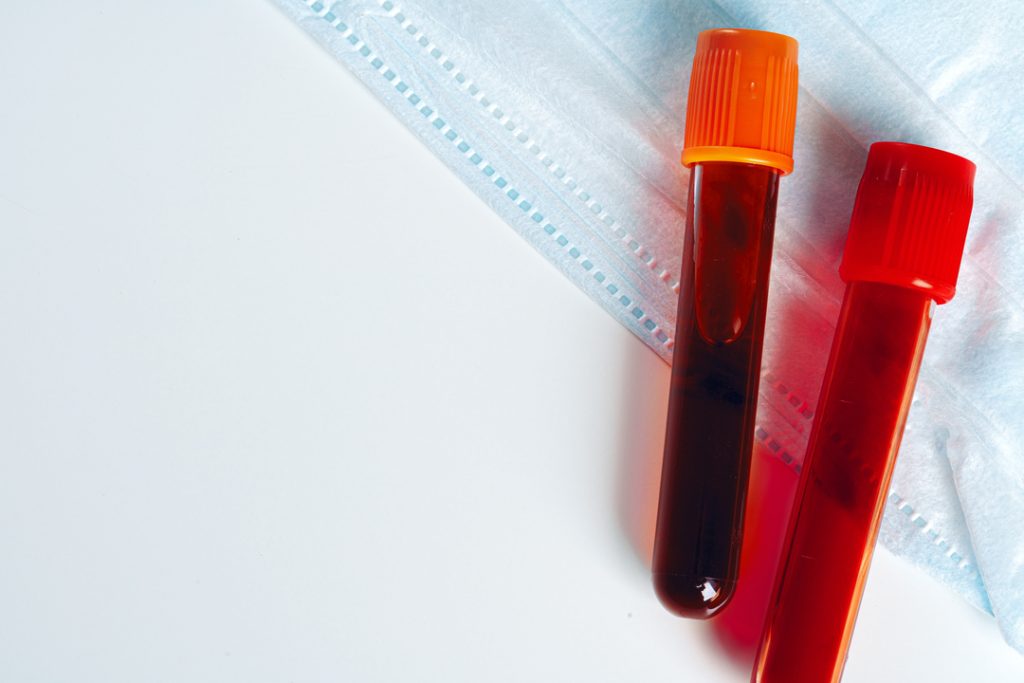Adderall is a widely prescribed medication used primarily to treat attention deficit hyperactivity disorder (ADHD). This stimulant drug is composed of amphetamine salts, which work by increasing the levels of certain chemicals in the brain that regulate attention and impulse control. While Adderall is effective in managing symptoms for many individuals, it is important to understand how long the drug stays in the system and how it can be detected through various testing methods.
How Long Does Adderall Stay in the System?
In short, the duration of Adderall detection can vary depending on the testing method used. In blood, Adderall can typically be detected within hours after ingestion and may remain detectable for up to 2-3 days. In urine, the drug can be detected for approximately 1-2 days after use. Saliva testing can detect Adderall for a shorter window of time, usually within 24-48 hours.

Understanding Adderall and Its Uses
What is Adderall?
Adderall is a combination of amphetamine and dextroamphetamine, two central nervous system stimulants. By affecting the levels of certain neurotransmitters, including dopamine and norepinephrine, Adderall helps to improve focus and reduce impulsivity in individuals with Attention Deficit Hyperactivity Disorder (ADHD).
Amphetamine and dextroamphetamine work by increasing the release and blocking the reuptake of these neurotransmitters in the brain. This leads to an increase in the concentration of dopamine and norepinephrine, which are responsible for regulating attention, motivation, and impulse control.
It is important to note that Adderall should only be used under the supervision of a healthcare professional, as it can have potential side effects and risks.

The Science Behind How Adderall Works
When taken orally, Adderall is absorbed into the bloodstream and reaches the brain. Once there, it stimulates the release of dopamine, a neurotransmitter involved in pleasure and reward pathways. This dopamine release is what contributes to the improved focus and attention seen in individuals taking Adderall.

It is important to note that while Adderall can be effective in managing ADHD symptoms, it is not a cure for the disorder. It is just one component of a comprehensive treatment plan that may also include behavioral therapy and other interventions.
Adderall’s Effect on the Brain
As mentioned earlier, Adderall works by increasing the release of dopamine in the brain. Dopamine is a neurotransmitter that plays a crucial role in various brain functions, including movement, motivation, and reward. By increasing dopamine levels, Adderall helps to enhance focus, attention, and impulse control in individuals with ADHD.

However, the exact mechanism of how Adderall affects dopamine release is still not fully understood. Researchers believe that it primarily works by blocking the reuptake of dopamine, which means that it prevents the brain from reabsorbing the neurotransmitter too quickly. This leads to an increased concentration of dopamine in the synaptic cleft, the space between neurons, resulting in improved communication between brain cells.
Furthermore, Adderall also affects other neurotransmitters in the brain, such as norepinephrine and serotonin. These neurotransmitters are involved in regulating mood, sleep, and appetite. By modulating the levels of these neurotransmitters, Adderall can have additional effects on an individual’s overall well-being.
The Role of Metabolism in Drug Processing
Metabolism plays a significant role in processing Adderall and determining how long it stays in the system. The liver metabolizes the drug, breaking it down into smaller compounds that can be eliminated from the body. Factors such as age, overall health, and individual metabolic rate can influence how quickly Adderall is processed and eliminated.

It is worth noting that the rate of metabolism can vary between individuals, leading to differences in how long Adderall remains active in the body. Some people may metabolize the drug more quickly, resulting in a shorter duration of action, while others may have a slower metabolism, leading to a longer-lasting effect.
Additionally, certain medications and medical conditions can also affect the metabolism of Adderall. For example, drugs that inhibit the activity of liver enzymes responsible for drug metabolism can prolong the effects of Adderall. On the other hand, substances that induce these enzymes can accelerate the breakdown and elimination of the drug.
Understanding the role of metabolism in drug processing is essential for healthcare professionals to determine the appropriate dosage and frequency of Adderall administration. By considering individual metabolic factors, healthcare providers can optimize treatment outcomes and minimize potential side effects.

3 Factors Influencing the Duration of Adderall in the System
Adderall, a prescription medication commonly used to treat attention deficit hyperactivity disorder (ADHD), can have varying durations in the human body. Several factors contribute to how long the drug remains detectable in the system, including dosage, frequency of use, individual metabolic rate, age, and health conditions.
-
Dosage and Frequency
The dosage and frequency of Adderall use play a significant role in determining how long the drug stays in the system. Higher doses and more frequent use can result in a longer detection window. This means that individuals who take larger amounts of Adderall or use it more frequently may have traces of the drug in their system for a longer period of time.

It is important to note that Adderall comes in different formulations, including immediate-release and extended-release versions. Extended-release formulations are designed to release the medication gradually over an extended period. As a result, these formulations may stay in the system longer compared to immediate-release versions.
-
Individual Metabolic Rate
Each person’s metabolism is unique and can influence how quickly the body processes and eliminates Adderall. Metabolism refers to the chemical processes that occur within the body to convert food and substances into energy. Individuals with faster metabolisms may clear the drug from their system more rapidly, while those with slower metabolisms may have a longer detection window.
Factors that can affect metabolic rate include genetics, body composition, physical activity level, and overall health. For example, individuals who engage in regular exercise may have a faster metabolism, leading to quicker elimination of Adderall from their system.

-
Age and Health Condition
Age and overall health can also impact the duration of Adderall in the system. Younger individuals tend to have faster metabolisms compared to older individuals. This means that younger people may process and eliminate Adderall more quickly, resulting in a shorter detection window.
Furthermore, underlying health conditions can affect the body’s ability to process and eliminate drugs. For instance, individuals with liver or kidney disease may experience impaired drug metabolism and elimination, leading to a longer duration of Adderall in their system.
It is essential for healthcare professionals to consider these factors when prescribing Adderall or conducting drug tests. Understanding the various factors that influence the duration of Adderall in the system can help ensure accurate interpretation of drug test results and appropriate medical management.
Detecting Adderall in the Body
Drug Testing for Adderall
Adderall can be detected through various drug testing methods. Commonly used tests include urine, blood, and saliva tests. These tests can determine if Adderall has been used recently but do not measure the precise duration the drug has been in the system.
The Duration of Adderall in Blood, Urine, and Saliva
- Blood Tests: After someone takes Adderall, it can usually be identified in their bloodstream within a few hours. Typically, it remains detectable in blood for approximately 2-3 days after it has been ingested.
- Urine Tests: Urine tests are often used for drug screening due to their convenience and extended detection window. For Adderall, its traces can be found in urine for about 3-4 days following the last consumption.
- Saliva Tests: Saliva tests, while less common than urine tests, offer a quicker detection window. For Adderall, it can be detected within the 24-48 hour period after use.

The Side Effects and Risks of Long-Term Adderall Use
Physical Side Effects
Like any medication, long-term use of Adderall can come with potential side effects. Physical side effects may include increased blood pressure, elevated heart rate, dry mouth, headaches, and decreased appetite. It is essential to monitor these effects and consult with a healthcare professional if they become bothersome.
Psychological Side Effects
Psychological side effects of long-term Adderall use can include irritability, anxiety, restlessness, and changes in mood. In rare cases, individuals may also experience hallucinations or psychotic symptoms. Regular check-ins with a healthcare provider can help mitigate these risks and ensure the ongoing effectiveness and safety of Adderall therapy.

Adderall Withdrawal: Understanding the Challenges
Discontinuing Adderall can lead to Adderall withdrawal symptoms such as fatigue, depression, and an increase in ADHD symptoms due to the brain’s adjustment to the absence of elevated neurotransmitter levels. It is crucial to manage these symptoms under the guidance of a healthcare professional, who can provide strategies for a gradual reduction in dosage to facilitate a smoother transition.
Adderall Addiction Treatment at CBH in Florida
In conclusion, the duration of Adderall in the system can vary depending on several factors, including dosage, metabolism, age, and overall health. Drug testing methods such as blood, urine, and saliva tests can detect recent Adderall use, although the precise duration cannot be determined solely through these tests. Understanding the effects, risks, and potential side effects of long-term Adderall use is crucial for individuals prescribed this medication. Regular communication with healthcare professionals can help monitor the effectiveness and safety of Adderall therapy.

At Compassion Behavioral Health, we believe in a comprehensive approach to mental health and substance abuse treatment. By providing resources and support tailored to individual needs, we aim to empower individuals to lead healthier, more fulfilling lives. As part of our commitment to holistic recovery, Compassion Behavioral Health offers a specialized medical detox program for Adderall addiction, ensuring clients receive safe, medically supervised care during the withdrawal process. We also provide multiple levels of care, including residential treatment, partial hospitalization (PHP), and intensive outpatient programs (IOP), to support long-term recovery and sustained wellness. If you or a loved one is seeking guidance or has concerns related to medication use, call us today for expert assistance and advice.





